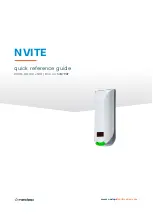
The Concept
The unique cabinet configuration of the Trident HG3
Close Field Monitoring System is designed to reduce
or eliminate many issues found in today's monitor sys-
tems. Some of these include:
•Limited Dispersion and Bandwidth •Doppler Distor-
tion • Phase Distortion •Inter-Modulation Distortion
•Cabinet Resonances •Edge Diffraction and other
problems associated with traditional monitor designs.
Bass Response
The use of a port can extend the usable response of a
low frequency speaker, but below resonance, the
speaker becomes uncontrolled and will flap wildly in
conventional ported systems. The Trident HG3 sys-
tem eliminated this problem by using a controlled
electronic roll-off below the speaker's usable response.
Separate subwoofers create additional problems by in-
troducing phase cancellations at crossover, and excit-
ing unwanted room nodes - eliminating the advantages
of near field monitoring. Separate sub-woofer place-
ment is a hit or miss proposition, guaranteed to cause
problems in poorly treated rooms
Through the use of a dual voice coil long throw sub-
woofer, in each speaker box, and optimal tuning, the
usable response is extended smoothly to 35 Hz in a
very small enclosure. Each sub-woofer has two high
powered MOS amplifiers to insure clean, distortion
free power. Further, the port is located outside the
path of all active speaker components to insure free-
dom from Doppler distortion at very low frequencies.
Below 90 Hz, the HG3 bass response is essentially
omni-directional. From 90 Hz up to the crossover
point of 320 Hz, the bass response narrows to about
180 degrees. Above 320 Hz, any large diameter
speaker's dispersion narrows and the frequency re-
sponse becomes ragged and uneven. Not a good
thing.
Midrange Response
The most critical range in any monitor system is the
midrange; that's where the voice resides, the bulk of
the guitar's sound, and the overall detail of the music.
It's strange that some manufacturers would split the
vocal range in the middle, and assign part of the vocal
to the woofer, and the other part of the critical vocal
range to another speaker. It just doesn't make sense.
Part of the vocal (in a typical two-way system) is
being modulated by pumping bass, and the other part
is bouncing off the ends of the cabinet, creating edge
diffractions. The result is smeared midrange, bad
stereo imaging, and poor off axis response. The Tri-
dent HG3 uses crossover points set at 320 Hz and
3,500 Hz to eliminate those problems. The unique cab-
inet design takes care of the rest.
The Cylinder
The midrange speaker is mounted in an isolated, 6" di-
ameter, damped, cylinder, to eliminate edge diffrac-
tions and woofer/cabinet resonance interactions. The
cylinder also houses the 1-1/8" silk dome tweeter, its
crossover, plus the mid and tweeter level controls. A
separate 60 Watt amplifier drives the cylinder mid and
treble c omponents.
Trident HG3 Close-Field Monitor System
4
































